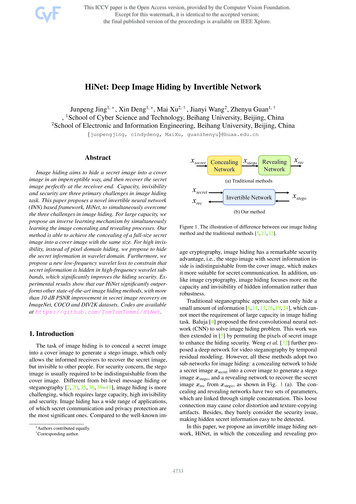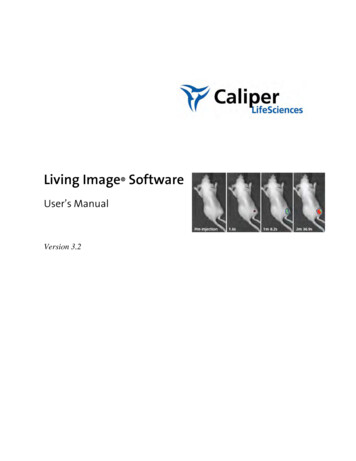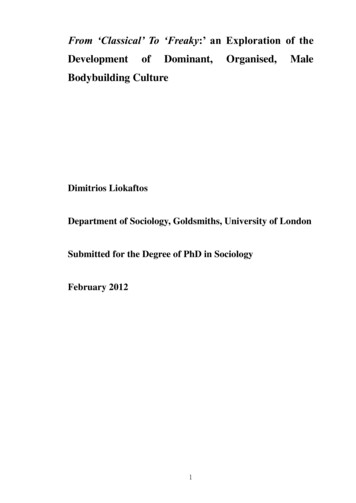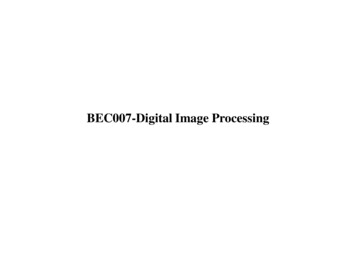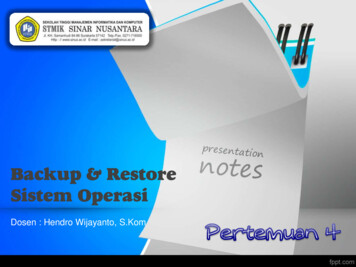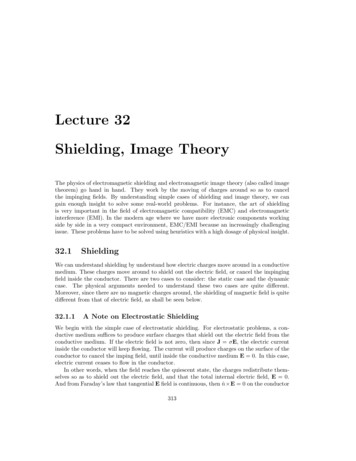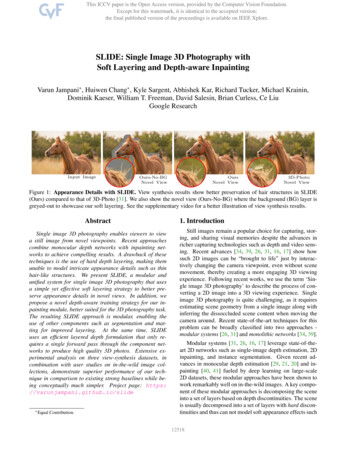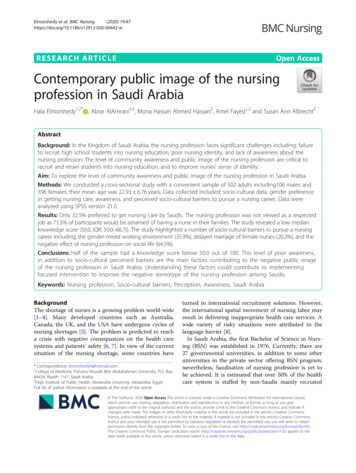
Transcription
Elmorshedy et al. BMC Nursing(2020) EARCH ARTICLEOpen AccessContemporary public image of the nursingprofession in Saudi ArabiaHala Elmorshedy1,2* , Abrar AlAmrani3,4, Mona Hassan Ahmed Hassan2, Amel Fayed1,2 and Susan Ann Albrecht5AbstractBackground: In the Kingdom of Saudi Arabia, the nursing profession faces significant challenges including; failureto recruit high school students into nursing education, poor nursing identity, and lack of awareness about thenursing profession. The level of community awareness and public image of the nursing profession are critical torecruit and retain students into nursing education, and to improve nurses’ sense of identity.Aim: To explore the level of community awareness and public image of the nursing profession in Saudi Arabia.Methods: We conducted a cross-sectional study with a convenient sample of 502 adults including106 males and396 females, their mean age was 22.93 6.76 years. Data collected included; socio-cultural data, gender preferencein getting nursing care, awareness, and perceived socio-cultural barriers to pursue a nursing career. Data wereanalyzed using SPSS version 21.0.Results: Only 32.5% preferred to get nursing care by Saudis. The nursing profession was not viewed as a respectedjob as 71.5% of participants would be ashamed of having a nurse in their families. The study revealed a low medianknowledge score (50.0, IQR: 50.0–66.7)). The study highlighted a number of socio-cultural barriers to pursue a nursingcareer including; the gender-mixed working environment (35.9%), delayed marriage of female nurses (20.3%), and thenegative effect of nursing profession on social life (64.5%).Conclusions: Half of the sample had a knowledge score below 50.0 out of 100. This level of poor awareness,in addition to socio-cultural perceived barriers are the main factors contributing to the negative public imageof the nursing profession in Saudi Arabia. Understanding these factors could contribute to implementingfocused intervention to improve the negative stereotype of the nursing profession among Saudis.Keywords: Nursing profession, Socio-cultural barriers, Perception, Awareness, Saudi ArabiaBackgroundThe shortage of nurses is a growing problem world-wide[1–4]. Many developed countries such as Australia,Canada, the UK, and the USA have undergone cycles ofnursing shortages [5]. The problem is predicted to reacha crisis with negative consequences on the health caresystems and patients’ safety [6, 7]. In view of the currentsituation of the nursing shortage, some countries have* Correspondence: elmorshedyh@hotmail.com1College of Medicine, Princess Nourah Bint Abdulrahman University, P.O. Box:84424, Riyadh 1167, Saudi Arabia2High Institute of Public Health, Alexandria University, Alexandria, EgyptFull list of author information is available at the end of the articleturned to international recruitment solutions. However,the international spatial movement of nursing labor mayresult in delivering inappropriate health care services. Awide variety of risky situations were attributed to thelanguage barrier [8].In Saudi Arabia, the first Bachelor of Science in Nursing (BSN) was established in 1976. Currently, there are27 governmental universities, in addition to some otheruniversities in the private sector offering BSN program;nevertheless, Saudisation of nursing profession is yet tobe achieved. It is estimated that over 50% of the healthcare system is staffed by non-Saudis mainly recruited The Author(s). 2020 Open Access This article is licensed under a Creative Commons Attribution 4.0 International License,which permits use, sharing, adaptation, distribution and reproduction in any medium or format, as long as you giveappropriate credit to the original author(s) and the source, provide a link to the Creative Commons licence, and indicate ifchanges were made. The images or other third party material in this article are included in the article's Creative Commonslicence, unless indicated otherwise in a credit line to the material. If material is not included in the article's Creative Commonslicence and your intended use is not permitted by statutory regulation or exceeds the permitted use, you will need to obtainpermission directly from the copyright holder. To view a copy of this licence, visit http://creativecommons.org/licenses/by/4.0/.The Creative Commons Public Domain Dedication waiver ) applies to thedata made available in this article, unless otherwise stated in a credit line to the data.
Elmorshedy et al. BMC Nursing(2020) 19:47from India and the Philippine, with limited numbers ofexpatriate nurses are recruited from western countries,Malaysia and the Middle East [9–11]. This diversity creates language barriers which were perceived as a causeof workplace violence towards nurses as demonstratedin one study conducted in Riyadh [12]. In addition, language barriers may affect the quality of service offered topatients [13].Saudisation of all the workforce sectors including thehealth care is one of the 2030 goals in the KSA- that isincreasing the percentage of Saudi nationals participating in the workforce and reducing of the percentage ofexpatriates. Despite the efforts to establish this goal, theSaudi Ministry of Health statistics in 2012 revealed thatexpatriate staff represents 50% of the nursing workforce[9]. Of note, the current situation reflects a significantincrease in the proportion of Saudis in the nursing profession compared to the previous report (Saudi Ministryof Health in 2008) which pointed out that Saudi nursescomprised only 29.1% of the total nursing workforce.However, the rate of Saudi nurses in private hospitals isas low as 4.1% [14, 15]. The underlying factors of shortage in Saudi nurses as addressed by Saudi educators andleaders include; cultural challenges, educational challenges, organizational challenges reflected by weak nursing authority and lack of acknowledgement for Saudinurses and challenges in the working environment including; language barrier, gender-mixed working environment, and long working hours) [16].Negative public perception of the nursing profession isa world-wide problem. Studies pointed out that improving the public image of nursing is fundamental in adopting a favorable nursing identity [17], while the poorimage is likely to limit the consideration of nursing as acareer choice [18, 19]. In the UK, one study pointed to:Students’ feelings of stress, not being valued, and havingunmet expectations [20]. Of note in the KSA, most families might discourage their daughters to enroll in jobswith gender-mixed working environment [21].Negative public image is influential for considering thenursing career as well as for retention of nurses in thenursing profession. Numerous studies highlighted thedirect effect of the negative public image on a nurse’ssense of identity [10, 22–24]. A study in Saudi Arabia revealed that satisfaction of nurses is linked to a favorablenursing image [25]. In addition, the role of nursing education institutions is vital in shaping the nursing identity.Freshmen nursing students mainly reflect the generalviewpoint of society as they only have a limited understanding about nursing [15, 26, 27]. A study conductedin Turkey demonstrated that students didn’t have sufficient knowledge regarding nursing at the beginning oftheir education, while an introduction to a nursingcourse has improved the students’ understanding of thePage 2 of 8nursing profession [27]. Also, media projection aboutnursing could play a fundamental role to influence thepublic image of nursing [22].Most of the published studies in Saudi Arabia were focused on nursing students and graduates [10, 21, 24, 25],with very limited data about the public image which iscrucial if missing in shaping the nursing identity in theKSA. Hence, the main objective of this study is to explore the level of community awareness and publicimage of the nursing profession in Saudi Arabia. Resultswould help to formulate intervention programs to improve the public image of the nursing profession leadingto more recruitment, and retention of Saudis in thenursing profession.MethodsSubjectsAdult Saudi individuals of both genders were invited toparticipate in the current study.Study settingsPrincess Nuorah Bint Abdulrahman University (PNU) inRiyadh city, the capital of the KSA. To portray the majority of the Saudi community, we included students enrolledin non-health colleges only as they contributed to morethan 90% of the total 50,000 students enrolled at PNU. Because PNU is a female university, and males in the Arabculture are influential in decision-making [28], we included adult male volunteers recruited from big malls inthe city to our study sample. The variability in the socioeconomic status, age, and educational levels in mall visitors might better represent the community.Study design and samplingWe conducted a cross-sectional study using a convenient sample of 502 volunteers of both genders. A posthoc power analysis revealed that a study of at least thissize, assuming a prevalence of 50% negative perception,7% allowable error in the estimate and 95% confidence,could detect differences with a power of 0.85.Ethical issuesThe current study was conducted in accordance withthe Declaration of Helsinki; the study protocol was approved by the Institutional Review Boards (IRB) of Princess Nourah Bint Abdulrahman University, Riyadh, KSA.Participants/guardians were consented verbally and wereinformed that their participation is voluntary, the dataare confidential, and that they can withdraw from thestudy at any point. The IRB recommends the use of verbal consent in survey procedures unless information isobtained in such a manner that human subjects can beidentified or subjects’ responses outside the research
Elmorshedy et al. BMC Nursing(2020) 19:47could place them at risk of criminal or civil liability ormay damage their employability, or reputation.Tool of data collectionThe researchers developed the questionnaire after athorough review of the literature with modification tosuit the Saudi culture. It included the following sections;1- socio-cultural data such as age, gender, education,and if there are nurses among the family members. Sections 2–4 included items which could affect the publicimage about the nursing profession. The second sectioninquired about the preference of caregivers with regardto gender and nationality, rating of nursing skills offeredby Saudi nurses, and stigma of the nursing profession.The third section was focused on awareness about nursing education and the nursing profession; it included sixmultiple response questions, the correct answer scoredas one, and the wrong answer scored as zero. The totalawareness score equaled 6. The fourth section addressedthe perceived barriers to engage in a nursing career, andincluded seven questions structured on a Likert scales;the total perception score equaled 27. before application,the questionnaire was piloted on a sample of 20 individuals to determine the face validity, and necessary modifications were included. The final format was selfadministered to participants volunteers.Analysis of dataData were checked for completeness and were analyzedusing SPSS version 21.0. Percentages, mean, median, andinterquartile range (IQR) were used to describe the data.Awareness and perceived barrier scores were calculatedas a percentage of the maximum score. As the distribution of scores was not symmetric, so it was presented asmedian with inter-quartile-range (IQR). Group comparison in median score was performed using the nonparametric Mann-Whitney test for two groups and theKruskal Wallis test for more than two groups with Dunnpost-hoc procedure in case of significant results andusing the adjusted p-values to control type I error. A pvalue 0.05 was considered significant. Multiple stepwise logistic regression analysis with Backward methodwas used to extract the most significant potential factorsassociated with awareness and perceived barriers of female nursing profession. Odds ratios of the outcomesadjusted for other variables was obtained with its 95%confidence interval.ResultsThe study encompassed 502 adult Saudis: 106 males(21.1%) and 396 females (78.9%), their mean age was22.93 6.76 with a median of 20 years. The majoritywere unmarried (80.3%). Overall, 74.3% were at university level of education or higher, out of the 106 males,70Page 3 of 8(66.0%) were at university level of education or higher,while out of 396 females, 303 (76.5%) were at universityeducation or higher (Table 1). In general, 81.5% preferred female nurses, while only 32.5% preferred Saudisto provide nursing care. Among those who experiencedSaudi caregivers, only 40.8% rated the service as excellent. Less than half of male participants reported thatthey would marry a nurse, and as much as 71% of thetotal sample would be ashamed if they have a nurse intheir family (Table 2).Regarding awareness about the nursing profession,Table 3 shows that 61% of participants considered nursing as subordinate to physicians. Moreover, as much as68.9% were unaware that nurses could achieve highermanagerial positions, and about one-third of participantswere unaware about the title of graduates from nursingcollegiate programs. Additionally, participants demonstrated lack of knowledge concerning the length of timerequired to acquire a bachelor degree in nursing. Intotal, the median awareness score was only 50.0%, meaning that, half of participants scored less than 50.0% ofthe total score of 100%.The median score of perceived barriers of the nursingprofession was 51.85% of the maximum score. Differences in Language, and culture were perceived as barriers to get engaged in the nursing profession by 12%and 31.7% respectively. More than one-third of participants reported that gender-mixed working environmentTable 1 Distribution of the study sample according to sociodemographic characteristicsSociodemographic characteristics, n 502Frequency %SexMale10621.1Female39678.915-16633.120-22344.425 11322.5Age in yearsMarital statusEducationHouseFemale nurse in thefamilyMean SD22.9 6.8Married9919.7Unmarried40380.3Below secondary234.6Secondary (Highschool)10621.1* University or No35370.3SD Standard deviationUniversity or higher: Enrolled or completed their degrees* Out of the 106 males,70 (66.0%) were at university level of education orhigher, while out of 396 females, 303 (76.5%) were at university level ofeducation or higher
Elmorshedy et al. BMC Nursing(2020) 19:47Page 4 of 8Table 2 Preferences of nursing care and stigma of the nursingprofession (N 502)QuestionResponsePreference of care giver accordingto genderMale nurse9318.5Femalenurse40981.5Preference of care giver accordingto nationalitySaudi16332.5Non-Saudi10220.3Getting care by Saudi femalesFrequency %Never mind23747.2Yes29959.6No20340.412240.8Rating of Saudi female nursing carea ExcellentVery ree234.6Preference to marry a female nurseb Yes4643.4No6056.6Stigma of nursing(ashamed to have a nurse in myfamily)aAsked to those who received care by Saudi female nurses (299) bAsked tomales onlyis a barrier for nursing practice, and about one-fifth consider that being a female nurse will delay marriage. Inaddition, 64.5% of participants claim that nursing profession affects female social life negatively (Table 4).Table 5 demonstrates factors associated with awareness and perceived barriers regarding the nursing profession. Higher level of education, having a nurse in thefamily, and marriage are associated with a higher awareness score. The perceived barrier score was higheramong more educated individuals: 55.6, 51.9, and 48.2%for graduates of high school, university versus those whojust can read and write respectively. Of note, the perceived barrier score was higher among those having anurse in the family.Table 6 shows that the unmarried participants and thosewith lower educational levels were mor likely to have poorknowledge. Those without a nurse family member hadlower perceived barriers of nursing profession (AOR 0.661, 95% CI: 0.443–0.985) while those who just read andwrite had higher perceived barriers (AOR 1.679, 95% CI:1.062–2.655) compared to the highly educated respondents.DiscussionThe study revealed poor level of awareness about thenursing profession and distrust in Saudi caregivers.Surprisingly, about one-third only preferred to get thenursing care by Saudis. Moreover, the rating of Saudicaregivers was deemed excellent by only 40%. Inaddition, nearly three-quarters would be ashamed if theyhave a nurse in the family, and less than 50% of malesprefer to marry a nurse. The study highlighted numerous barriers including; mixed working environment, delayed marriage of female nurses, and the negative effectof the nursing profession on social life. Regression analysis revealed no gender difference in the level of awareness, while those with low level of education, and unmarried participants were more likely to have poorknowledge. Perceived barriers are more likely among lesseducated, while it was less likely among those reportedthat there were no nurses among their family members.The low preference for Saudi caregivers might reflect poor image and distrust in the national caregivers; this would be very distressing and demotivating for Saudi nurses and for those who mightconsider a nursing career in the future. In addition,nearly three-quarters of participant perceived thatthey would be ashamed of having a nurse amongtheir families. In accordance with our results, a Studyin Saudi Arabia revealed that nursing as a childhooddream was not appealing, nor family support was influential to pursue a nursing career [21]. One studyreported that as much as 87.8% of Saudis didn’t prefer a nursing career for their family members [29].Surprisingly, a Chinese study demonstrated that parents would not encourage their children to enroll innursing education [30]. The observed positive perception of Omani university students about the nursingprofession might reflect a reporting bias, since thenumbers of the nursing students outweigh those fromother disciplines [31]. Secondly, other factors concerning the heath care policies to recruit nationalsand media marketing of the nursing profession inOman should not be ignored. Of note, underestimating the skills of Saudi nurses should gain more attention by Saudi leaders and educators in the health caresectors as it might reflect a real gap between theoryand practice as highlighted in a recent study [16].However, in this study, the preference of females ascaregivers stems from the perception that nursing iswomen’s occupation. In addition, cultural norms rejectgetting care by opposite gender especially for females.Regarding the level of awareness about the nursingprofession, it is striking that most of participants in thepresent study viewed the role of nursing in health caresettings as complementary to physicians, and about onethird do not know the exact job title of graduates fromnursing college or institutes. Additionally, participantsdon’t know even the duration required to get a bachelor’s degree in nursing.
Elmorshedy et al. BMC Nursing(2020) 19:47Page 5 of 8Table 3 Awareness about the nursing profession (N 502)Knowledge ItemFrequencyNursing dutiesJob title of graduates of nursing programs below bachelorJob title of graduates of bachelor programDuration of bachelor’s degree (Including internship)Nursing has several specialtiesA nurse can be promoted to a hospital manager19639.0Complementary to physician30661.0Nurse specialist6713.3Technical nurse24949.6Don’t know18637.1Nurse specialist28657.0Technical nurse5210.4Don’t know16432.7Two years224.4Three5410.8Four9719.3Five15230.3Don’t %Provide medical care, follow-up and health educationMedian score as percentage of the total score, (IQR)50.0, (50.0–66.7)IQR Inter-quartile-range (Q1 – Q3)aScore range 0–6 (0–100%), higher score indicates better knowledgeThe level of public awareness about the nursing profession is critical for how they view the nursing career.Previous studies across different cultures confirmed theperceived attenuated role of nurses compared to physicians. These negative stereotypes view nurses as havingno status and describe them as physicians’ assistants andancillary workers [26, 30, 32]. In a study conducted inIran, students emphasized that the social status of nursesis not desirable, as they are considered handmaidens ofphysicians and dutiful hospital employees. For example,one student mentioned: “although nurses are sometimesperceived as educated, their main task is to obey and follow physicians’ orders and their caring skills are not appreciated” [22].Similarly, a recent study in Saudi Arabia which included over 700 participants of both genders, revealedthat more than one-third of participants perceived nursing as a profession that is auxiliary and subservient tophysicians, and therefore study participants claim thatthere is no need for higher academic qualifications [21].Table 4 Perceived barriers of public to engagement in the nursing profession, n 502Perceived barriersStrongly agreeAgreeNeutralDisagreeStrongly n with different on with different culture459.011422.712124.110921.711322.5Being Saudi is viewed as a skilled nurse91.8326.417935.715029.913226.3Poor public image of nursing profession438.65410.87414.716132.117033.9Mixed working d marriage of a female nurse357.06713.310721.315029.914328.5Nursing profession affects female social lifeExtremelya84bMedian score as percentage of the total, (IQR)16.751.85, (44.44–59.26)Freq FrequencyIQR Interquartile range (Q1 -Q3) aReverse score order bScore range 0–27 (0–100%)ModeratelyMarginallyNot at all2401285047.825.510.0
Elmorshedy et al. BMC Nursing(2020) 19:47Page 6 of 8Table 5 Association between sociodemographic characteristics, awareness and perceived barriers of the nursing profession (N 502)Sample characteristicsGenderAge in yearsMarital statusEducationHouseFemale nurse in the familyAwarenessPerceived barriersMedian(IQR)PMedian(IQR)PaMale66.7 (50.0–83.3)0.12651.9 (44.4–59.3)0.863Female50.0 (50.0–66.7)15-50.0 (33.3–66.7)20-50.0 (50.0–66.7)25 66.7 (50.0–83.3)Married66.7 (50.0–83.3)Unmarried50.0 (33.3–66.7)Read & write50.0 (33.3–66.7)High school50.0 (33.3–66.7)University and higher66.7 (50.0–66.7)Private50.0 (50.0–66.7)Rented66.7 (33.3–66.7)Yes66.7 (50.0–66.7)No50.0 (33.3–66.7)a51.9 (44.4–59.3)0.06951.9 (44.4–59.3)0.88151.9 (44.4–59.3)51.9 (44.4–59.3)b0.00151.9 (44.4–59.3)0.22551.9 (44.4–59.3)0.001bc48.2 (48.2–59.3)0.043bd55.6 (48.2–63.0)51.9 (44.4–59.3)0.54151.9 (44.4–59.3)0.046b55.6 (48.2–63.0)0.70451.9 (44.4–59.3)0.032b51.9 (44.4–59.3)aMann-Whitney test for two groups and Kruskal-Wallis test for more than two groupsbP 0.05 (Significant), IQR Interquartile range (Q1 -Q3)cPost-hoc test indicated significant difference between University & higher versus Read & writedPost-hoc test indicated significant difference between University & higher versus High schoolThis means that the community in Saudi Arabia doesn’tvalue the skills and competencies acquired throughhigher academic education.Despite the sincere efforts of Saudisation of the workforce in the KSA, expatriates remain to constitute a considerable proportion of the nursing workforce [25].Saudi culture may regard the nursing professionTable 6 Multiple stepwise logistic regression analysis ofpossible factors in relation to awareness and perceived barriersof the nursing profession (N 502)Sample characteristicsMarital statusEducationFemale nursein the familyAwarenessPerceived barriersAOR95% CIAOR95% CIMarried1Unmarried1.991.10–3.61Read & write2.741.15–6.51High school1.811.12–2.92University and dent variables; Perceived barriers ( median 0, median 1),Knowledge (Below median 1, Median or above 0)AOR Adjusted odds ratio, CI Confidence intervalunfavorable work atmosphere and hence discouragetheir children to pursue a nursing career. The presentstudy revealed that a considerable proportion of thestudy sample amounted to 64.5% claimed negative consequences of the nursing profession on social life because of long working hours and night shifts, otherbarriers include delayed marriage and gender-mixedworking environment. Regression analysis showed thatless educated individuals were more likely to perceivebarriers, probably because of lack of knowledge. The observation that barriers were more likely if there werenurses among the family further indicates the challengesfaced by Saudi nurses.It is likely that the global image of the nursing profession is negative. Previous studies demonstrated thatnursing is viewed as a less desirable profession becauseof difficult working conditions, inadequate financialcompensation, low level of autonomy, limited career opportunities, and being viewed as ancillary members ofthe healthcare team [33].Finally, this study demonstrates low level of publicawareness and reflects poor public image of the nursingprofession. Such information is paramount for effectiveinterventions to raise community awareness and modifythe negative image of the nursing profession. Hopefully,the nursing identity will be improved leading to recruitment of high achievers and retention of candidates intothe nursing career.
Elmorshedy et al. BMC Nursing(2020) 19:47Limitations of the studyThe study was conducted in Riyadh the capital city ofthe KSA, so generalizability of the study is limited tosimilar settings. Should we consider sub-urban and ruralcommunities, the data collection tool needs further validation and reliability testing. The convenient samplingtechnique, and the unbalanced gender representationadd to study limitations.ConclusionsThe study demonstrated a negative public image of thenursing profession, only, one-third of participants preferred to get nursing care by Saudis, and the nursingprofession was not viewed as a respected job by majority.Awareness about the nursing profession was poor, ashalf of participants scored below 50% out of 100. Thestudy highlighted a number of barriers to pursue a nursing career including; working in a gender-mixed environment, delayed marriage of females, and poor sociallife. These findings are crucial to implementing focusedintervention strategies in the future to improve the public perception of the nursing profession in the KSA.Supplementary informationSupplementary information accompanies this paper at nal file 1.AbbreviationsBSN: Bachelor of Science in Nursing; KSA: Kingdom of Saudi Arabia;UK: United Kingdom; PNU: Princess Nourah Bint Abdulrahman University;IQR: Interquartile range; AOR: Adjusted odds ratio; CI: Confidence intervalAcknowledgmentsThe authors acknowledge the study participants for their time and patienceto volunteer in the study.Authors’ contributionsHE Conceived the study idea and designed the study and drafted themanuscript. AA Collected the data and participated in the data entry andanalysis. MH Contributed to the study design and analyzed the data. AFContributed to the statistical analysis, critically reviewed the revised versionof the manuscript. SA critically reviewed and revised the manuscript. Allauthors read and approved the final manuscript.FundingThis research was funded by the Deanship of Scientific Research at princessNourah Bint Abdulrahman University through the Fast-track Research Funding Program. Funding has no role in study design, data collection, data analysis, decision to publish or preparation of the manuscript.Availability of data and materialsThe datasets of the current study are available from the correspondingauthor on reasonable request.Ethics approval and consent to participateThe study was conducted in accordance with the Helsinki Declaration, andapproved by the Ethical Review Boards of Princess Nourah Bint AbdulrahmanUniversity, Riyadh, KSA. The IRB recommends the use of verbal consent insurvey procedures unless information is obtained in such a manner thathuman subjects can be identified or subjects’ responses outside the researchPage 7 of 8could place them at risk of criminal or civil liability or may damage theiremployability, or reputation. Verbal consents were obtained from adults,while verbal assent of minors below 16 years-old along with verbal consentsfrom their guardians were obtained.Consent for publicationNot applicable.Competing interestsThe authors declare that they have no competing interests.Author detailsCollege of Medicine, Princess Nourah Bint Abdulrahman University, P.O. Box:84424, Riyadh 1167, Saudi Arabia. 2High Institute of Public Health, AlexandriaUniversity, Alexandria, Egypt. 3School of Nursing and Midwifery, Queen’sUniversity Belfast, Belfast, UK. 4King Fahd Medical City, Riyadh, Saudi Arabia.5School of Nursing, University of Pittsburgh, Pittsburgh, USA.1Received: 27 October 2019 Accepted: 2 June 2020References1. Canada H. A Report on the Nursing Strategy for Canada; 2003.2. Price SL, McGillis Hall L. The history of nurse imagery and the implicationsfor recruitment: a discussion paper. J Adv Nurs. 2014;70(7):1502–9.3. Price S. Future directions for career choice research in nursing: a discussionpaper. Int J Nurs Stud. 2009;46(2):268–76.4. Westendorf JJ. The nursing shortage: recruitment and retention of currentand future nurses. Plast Surg Nurs. 2007;27(2):93–7.5. Buchan J. Nurses moving across borders: ‘brain drain’ or freedom ofmovement? Int Nurs Rev. 2001;48(2):65–
Negative public perception of the nursing profession is a world-wide problem. Studies pointed out that improv-ing the public image of nursing is fundamental in adopt-ing a favorable nursing identity [17], while the poor image is likely to limit the consideration of nursing as a career choice [18, 19]. In the UK, one study pointed to:



